

| Recent records of the Harvestman Leiobunum sp. A from Nottinghamshire | ||
| .... | ||
| Due to the number of years
we have continued to survey the growing population of Leiobunum sp
A on the walls of Worksop Priory and elsewhere, we felt that a separate (and more easily
updatable)
page giving the resulting counts on www.eakringbirds.com and observational notes
was much needed. A brief history of Leiobunum sp.A In October 2009, we found a very dark, extremely long-legged Leiobunum type Harvestman on the wall of a Worksop house, which immediately stood out as being very different from any other Harvestman we had seen before. The Harvestman was found resting on a shaded, north-facing wall, in the rear garden of the property, in a an open position relative to cover provided by Ivy growing up the same wall. It was collected and taken home for photographing before being released. |
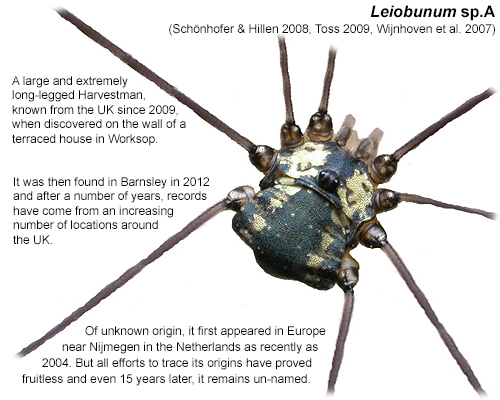 |
|
| ..... | ||
| In November
2011, a possible breakthrough came whilst searching for
images of Platybunus pinetorum, a recent
addition to the UK species list discovered by Paul
Richards at Sheffield in June 2010. Images found during a
Google search for the similar looking (to the Worksop
specimen) Leiobunum tisciae, turned up images of
an invasive and unknown Leiobunum found in parts
Germany, Switzerland, The Netherlands and Austria.
Further research quickly led us to the excellent paper "An
unidentified harvestman Leiobunum sp. alarmingly invading
Europe" (Arachnida: Opiliones) by Hay
Wijnhoven, Axel L. Schönhofer & Jochen Martens
and published in December 2007. One particular image of a male in the paper, seemed to match the Worksop specimen perfectly, so we emailed images of the Worksop specimen to Jochen Martens and Paul Richards for possible identification and confirmation. Both replied back with the conclusion that it was indeed Leiobunum sp. The Harvestmen still (February 2017) remains scientifically un-named. |
||
| ..... |
| Leiobunum sp.A
refound - a summary of the 2012
records Following the end of our three year wait to record Leiobunum sp. A again on October 13th 2012, we eventually went on to record a total of 13 males and nine females along the southern wall of the Priory. All the Leiobunum sp. A we found were found resting more or less at eye level, with only one female found about 20 feet up. They clearly preferred the vertical joints or tight recesses built along the southern side of the Priory walls. We made immediate follow-up visits the next day, recording a total of 20 individuals, before a final visit of the year on October 17th, recording a total of 18. 2013 records Numbers increased on those initially found 2012, with counts of 37 on August 15th, rising to 43 on September 9th. Most of both these counts, were found in two aggregations, usually situated under some degree of shelter via the building's stonework, with up to 27 on the south side of the Priory and 11 under an arch on the eastern side. A count of 46 made on September 22nd, was the highest count to date. |
| ..... | ||
| Summary of the 2014 surveys and records We made two visits to the site and immediately found a single aggregation of 81 Leiobunum sp. A, a few minutes into our search on August 9th 2014. The final total of 202, showed that there had been an enormous increase in numbers from 2013, possibly helped by the exceptionally mild Winter. Similar daytime roost sites, were used as in previous years, but we did note a substantial increase in numbers on the north (shaded) side of Worksop Priory. Our second visit was made nearly a month later on September 7th and counts had increased to 274. There were increased numbers of Leiobunum sp. A recorded within all aggregations found on our first visit. The aggregation of 81 had grown to 95 and there were several other aggregations which totalled well over 30 individuals. |
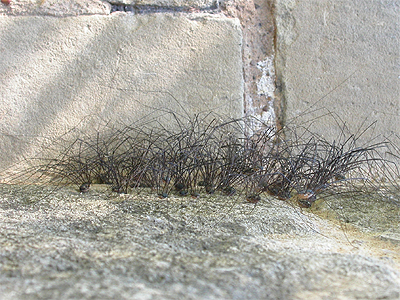 |
|
| ..... | ||
| 2015 surveys and records Our first visit of 2015 took place on August 2nd, which was a week earlier than in 2014. A total of 217 Leiobunum sp. A were counted, with many still immature, although there were already a few mature males present. Once again, the main aggregations were located in exactly the same positions on the Priory walls, as recorded in previous years. The largest single aggregation consisted of approximately 90 individuals, but higher than normal numbers were present on the eastern (recorded for the first time on the new section of the Priory) and the northern side. One immature male, was even found underneath the overhanging top stone of a grave and away from the main Priory walls. Our second visit took place on August 15th. A total count of 212 was made, with groups in similar positions and there was an increase in the numbers of small groups. One usually guaranteed aggregation under an arch on the eastern-end of the Priory had disappeared. |
||
| ..... | ||
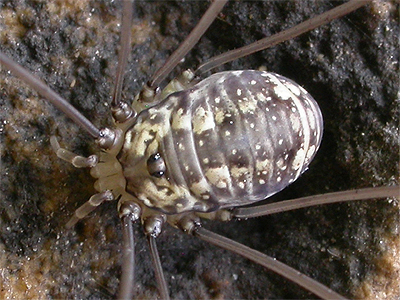 |
We returned to Worksop
again on September 4th, noting changes to the
distribution of Leiobunum sp. A on the north
side of the Priory and actually finding very few to be
present. Most were found on the warmer southern walls,
probably moving as a result of the recent spell of cold
northerly winds. A final total of 159 was disappointing,
but a check of an adjacent stone building proved
worthwhile, with a further 54 Leiobunum sp. A
recorded. Final total for the visit was 213, so
amazingly similar counts for all three visits this year
so far. On September 14th, we returned with wildlife cameraman James Dunbar to conduct another count. On arrival we immediately checked the first aggregation, which only a few weeks ago had held approximately 90 individuals. With the division of this aggregation noted on our previous visit, we noted a further reduction in numbers and after checking all the southern walls of the Priory, concluded that many Leiobunum sp. A had dispersed further afield, including one group which had aggregated on the north side of a large tomb. |
|
| ..... | ||
| No Leiobunum
sp. A were found to be present on the Priory's eastern
side and there were very few recorded along the northern
side. Clearly there was a large reduction in numbers and
possibly a more widespread dispersal away from the
Priory. A total of 116 Leiobunum sp. A were
found on the Priory and another 28 on an adjacent
building, which had reduced in number from 54 on our
previous visit. On October 8th, we visited Worksop Priory to conduct another survey. Since our last visit, the weather had been largely fine and dry with some pleasantly warm daytime temperatures, but very cool nights. What remained of any of the aggregations present on September 14th, had dispersed and most of the 34 Leiobunum sp. A recorded were found well distributed over the walls of the Priory and with very few on the Priory's north side. Our latest ever visit to Worksop Priory took place on November 1st. The day was pleasantly warm and sunny and a total of 31 Leiobunum sp. A (19m and 12f) were counted. There had been further movement/spread across the walls of the Priory, although none were present on the shaded north side. It was obvious that the remaining population had moved to the warmer southern and western walls and many Leiobunum sp. A were quite openly sat in full view. All were recorded singly or in twos, but not male with female. Most specimens had darkened further (especially the males) which we were surprised to find, now out-numbered females by almost two to one. Additional surveys for Leiobunum sp. A at other Worksop locations proved negative. |
||
| ..... | ||
| We continue to be
convinced that there are other sites in Worksop for Leiobunum
sp. A, but have had no success so far. The housing
estate where we first recorded this Harvestman back in
2009, was also surveyed again in 2015. Summary of the 2016 surveys and records A much earlier visit was made to Worksop Priory, with the intention being to search for juvenile Leiobunum sp.A, which we thought would be low on the Priory walls by the middle of June. Our visit was on June 17th and we found most of the 85 Leiobunum sp. A as sub-adults, but we did record a few juveniles (shown right) of just 2.5mm body length. There were no aggregations, but we did locate a loose group of eight sub-adults on the south wall of the Priory. None of the traditional aggregation areas on the Priory walls were occupied and most of the Leiobunum sp A found, were well scattered across the whole of the Priory's southern walls, usually in cracks and crevices, but often openly on the stonework in the manner of our native Leiobunum species. |
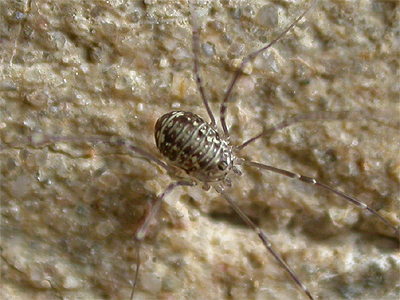 |
|
| ..... | ||
| Our second
visit to Worksop Priory ended up being slightly later
than we would have wished, but numbers had substantially
increased and approximately 223 Leiobunum sp. A
were counted on July 31st. Aggregations had again formed
in the exact same locations on the walls of the Priory
and on an adjacent stone building, as have been used in
previous years. The largest single aggregation totalled
94 individuals. Some two weeks into August and we visited Worksop again and found a record count of 308 Leibunum sp. A, on the Priory walls. The aggregation of 94 individuals on July 31st, had now risen to an impressive 130 by August 13th. This high count failed to increase (or even last) and by the time we conducted or next survey on September 10th, it was clear that the aggregations had broken up into considerably smaller groups. The largest group we found was just 24 and unusually, not in any of the traditional locations. A total of 146 Leibunum sp. A for the visit seemed small. Fig 1: Below are our visit dates and counts of the Leiobunum sp A population at Worksop Priory since 2012. The small graph depicts the highest count per year, reading from 2012 on the left. |
||
|
|||||||||||||||||||||||||||||||||||||||||||||||||||||
| ..... | |||||||||||||||||||||||||||||||||||||||||||||||||||||
| Late Summer and early Autumn visits took place on September 30th, producing a total of 63 Leibunum sp A, and then on October 16th, when the count had lowered again to 41. Approximately 27 of the 41 total were males and the 14 females were mostly well scattered along the southern and northern walls of the Priory. | |||||||||||||||||||||||||||||||||||||||||||||||||||||
Summary of the 2017 surveys and records We were slightly late conducting the first of the year's surveys, eventually visiting Worksop Priory a week later than we had originally planned to do. Our first visit on July 5th 2017, produced a total of approximately 232 Leiobunum sp.A, with several specimens noted as having recently completed moults. We noted many more old skins on the walls, where other individuals had also recently completed the process. The count of 232 represented the third highest count we have had on the Priory. The largest percentage were counted on the south-facing walls and typically (for an early date) we found on the north walls and none at all at the Prioy's eastern end. Leiobunum sp.A, looks set to be present in even higher numbers over the next few weeks, but we again found none on nearby buildings despite much searching. |
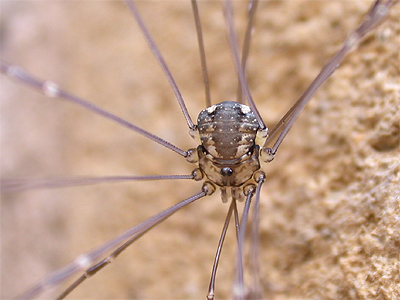 |
|
| ..... | ||
| We returned again on July 28th and almost bettered our record highest count of 308 Leiobunum sp.A recorded on August 13th 2016. We fell short by just two, counting 306 and with a single aggregation totalling approximately 100 individuals. Conditions were breezy, but we had many more on the northern walls of the Priory, than has ever been usual. | ||
| .......... | ||
| Summary of the 2018
surveys and records Following the coldest Winter for a number of years, with some late snow, we wondered how Leiobunum sp.A had survived since our last visit of the previous year. Our first visit to Worksop Priory was on July 12th, during a period of prolonged, hot and dry weather. We counted approximately 170 individuals, of which quite a number were in the process of moulting. The distribution changes noticed last year were continuing and none were found on the eastern end of the Priory, but a good number were found on the northern walls. We presumed that the increase on the northern side, was due to Leiobunum sp.A avoiding the daytime heat. Ten years on - the 2019 recordsAfter a very mild Winter, where there were only isolated frosts and just the briefest flurry of snow one morning, our first visit to survey Leiobunum sp.A took place on July 7th. It was only a brief survey which saw an unexpectedly small total of 47 sub-adults and a few juveniles. They were located in the usual spots on the south and north walls, with the largest aggregation being of 28. |
| .......... |
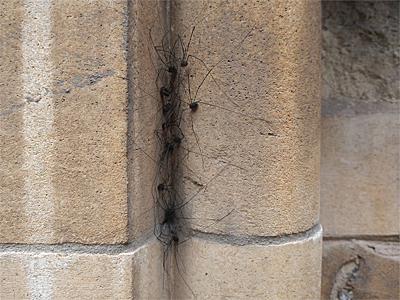 |
Summary of the 2020 surveys and records A first survey of 2020, took place on August 22nd. Only 58 Leiobunum sp.A. were found in three relatively small aggregation, the largest being of 28 rather restless individuals. This restlessness is thought to have been due to the very windy conditions over the previous few days, as this aggregation was rather exposed, but was in one of the usual (well used) locations on the south side of Worksop Priory. It will be interesting to see whether there is a build up of numbers in the next few weeks, or if numbers here have declined. A second visit took place on September 13th, after a large aggregation of Leiobunum sp.A. was found on Bridge Street in Worksop, by Ludwik Michalek the day before. This was the first report of any Leiobunum sp.A. away from Worksop Priory since the original finding back in October 2009 and confirmed our thoughts for a number of years, that it occurred at other sites. The aggregation were under an archway at the side of a cafe, close to the Bridge Street/Newcastle Street junction. From what I could see, the aggregation totalled 48 individuals. |
|
| .......... | ||
| A survey of Worksop
Priory's walls produced a count of 52 Leiobunum sp.A. so
it does seem as though there has been a decline in numbers on the
Priory, probably due to a localised expansion of range. A further visit on October 14th produced 23 Leiobunum sp.A. scattered in a group of nine and then mostly in one's and two's around the walls of the Priory. I returned to Worksop a few days later on October 18th, this time to check on the Bridge Street aggregation. A total of 13 were found, most still located in the archway next to the cafe, with a few singles found a few buildings away, but aggregations at both the Priory and Bridge Street are obviously splitting up now. 2021 records of Leiobunum sp.A A rather worrying first survey of the year on June 24th, with the finding of just a single sub-adult Leiobunum sp.A. located during a thorough survey of the Priory walls. It was in one of the regular aggregation locations, but worryingly all the other regular aggregation sites along the Priory walls remained vacant. Concerns remaining from the year's first survey of June 24th, were lessened by the time I'd counted approximately 50 individuals on a survey conducted on July 12th. There were no large aggregations, but some definite signs of grouping had developed since the last visit, although no group totalled more than six. Around ten individuals had already reached the moult prior to attaining maturity and still maintained the characteristic (but reduced) white knees typical of sub-adults. The age range of all Leiobunum sp.A found was interestingly varied - ranging from small juveniles, through sub-adults of varying size ranges, to those prior to becoming adult. Such variation in growth hasn't been recorded here before, when growth within the population has always been generally close. The Priory was next visited on August 6th and it was hoped that there would have been an increase in numbers. It turned out that there hadn't and 48 were found (all at the same stage of development now) but still a moult away from adult. The weather on the day was very showery and breezy, which are not the best of conditions, so maybe more were well tucked away and sheltering from the worst of the conditions. However, a month later proved that maybe some dispersal has taken place and numbers on a survey on September 9th were worse, with just 19 found. All were adults and of the 19, just four females were out-numbered by 15 males. Clearly something has occurred, or is occurring with this population. Possibly, colder weather the previous Winter may have had an affect on numbers here, or it could be that after years of establishment, the population is now spreading away from the walls of Worksop Priory. There's still so much to find out. I made a visit to Worksop B&Q on 11/10/21 and discovered 11 adult Leiobunum sp.A. on the outside walls of the garden centre area. Further searches saw a female present on the outside wall of B&Q near the main entrance and the record confirmed that there was the expected spread to new sites. To end the year's surveys, I made a quick visit to Worksop Priory on 27/12/21 and was surprised to find a single female on the southern wall of the Priory. This was the first December/Winter record of Leiobunum sp.A. in Nottinghamshire and with very mild temperatures forecasted into the new year, she should have survived into January. |
||
| 2022 records A very promising start to the survey season on July 13th, especially in view of the poor numbers of the previous year. A total of 104 Leiobunum sp.A were found in various stages of growth, although there were no notably large aggregations were present, with the largest aggregation containing approximately 26 individuals. However, on subsequent visits, rather than he expected increase in numbers of Leiobunum sp.A, there was an unexpected drop in numbers, with counts of 36 on 05/08/22 and then just 15 on 17/08/22. The only possible explanation and cause, could be that the low counts were a direct result of a second period of very hot, dry weather experienced before these latter two surveys? Another visit to the site on 31/08/22, again saw another count of just 36 individuals. But an interesting observation over the last three visits, was that all three counts were of single aggregations. No other individuals were recorded elsewhere on the Priory walls, or located on previously used adjacent walls. But it was not all bad news, with Leiobunum sp.A again recorded from the garden centre walls of B&Q on Sandy Lane, where two aggregations (one high on the shop frontage) totalled 25 on 05/08/22, but had risen to 71 in two aggregations on 31/08/22. |
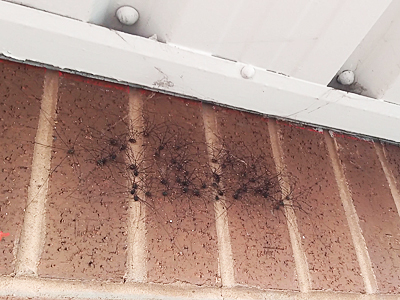 |
|
| .......... | ||
| By the time of the next
visit to Worksop on September 27th, just four (2♂ and 2 ♀) were
favouring the same location on the Priory wall, as the aggregation had
done all year. No others were found during a thorough search of the
Priory and in the immediate area, but I did go and check the site on
Bridge Street where Leiobunum sp.A was found in 2020 and was
pleased to see that around 30 were present in a tight aggregation. The
following day, I visited the B&Q store on Sandy Lane and found that
counts had dropped, but there were still 21 present on the garden centre
department's exterior wall. But more exciting news was to come in early October, when a single Leiobunum sp.A was found on the Nottingham Trent University's Arkwright Building on Shakespeare Street in the centre of Nottingham. Found by Oli Harrison on October 7th, this record surely has to be just one of numerous sites within the City and a great find. |
||
| Fig 2: Below is an updated version of the table showed in Fig 1. It shows the dates visited and the corresponding counts of Leiobunum sp.A at Worksop Priory between 2012 and the very latest counts from 2023. ' T ' is the total recorded. |
| .......... |
|
| .......... | ||||||||||||||||||||||||||||||||||||||||||||||||||||||||||||||||||||||||||||||||||||||||||||||||||
| 2023
records of Leiobunum sp.A The first visit to Worksop Priory on July 13th 2023, provided just two aggregations of Leiobunum sp.A from the walls of the Priory. A total of 49 Leiobunum sp.A were counted, with the largest of the two aggregations being made up of 39 individuals. There was better news in the way of success when approximately 70 were found on the walls of Nottingham Trent University buildings on Bilbie Walk, between Goldsmith Street and Shakespeare Street, with three aggregations forming part of the final count on July 23rd 2023. This site was discovered in late 2022 by Oli Harrison. |
||||||||||||||||||||||||||||||||||||||||||||||||||||||||||||||||||||||||||||||||||||||||||||||||||
| .......... | ||||||||||||||||||||||||||||||||||||||||||||||||||||||||||||||||||||||||||||||||||||||||||||||||||
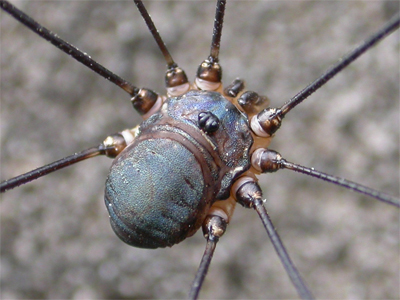 |
The folllowing day, I visited
B&Q on Sandy Lane in Worksop on July 24th and there were several
aggregations on the exterior wall of the garden centre section, plus an
additional small group on the front of the building. A total of 60
Leiobunum sp.A were counted, with the largest aggregations
including 18 and 22 individuals. Back at Worksop Priory and a count recorded on August 14th had increased sharply to 125 Leiobunum sp.A. This was up from the 49 present a month earlier on July 13th. There were three aggregations of 62, 24 and 22 individuals recorded and two smaller groups and odd singles also found. None were fully mature. 125 represented the highest Priory count since 2018 and while still a good count by the standards set in recent years, it is still less than half the 308 and 306 counts seen in 2016 and 2017 respectively. A visit on September 11th proved disappointing and just 58 Leiobunum sp.A were located, with just two aggregations of 25 and 20 individuals. It was noted that all individuals seemed to have moulted to maturity, since the last visit a month before. This visit did follow a week of very hot weather, which may have caused some movement to inaccessible areas of the Priory walls to escape the heat, or may just be natural dispersal now mature? |
|||||||||||||||||||||||||||||||||||||||||||||||||||||||||||||||||||||||||||||||||||||||||||||||||
| .......... | ||||||||||||||||||||||||||||||||||||||||||||||||||||||||||||||||||||||||||||||||||||||||||||||||||
| October's Worksop Priory
visit came on the 18th and a small number of Leiobunum sp.A,
were recorded within a small area of the southern walls of the Priory.
The count consisted of two males and two females, all in the favoured
area where most of September's count was made. A late in the year visit
on December 10th, saw a single female still present in the usual section
of Priory wall, which had surprisingly survived the snowfall and series
of very hard frosts with associated sub-zero temperatures. 2024 records of Leiobunum sp.A I made an early visit to Worksop on June 22nd, calling to check for Leiobunum sp.A. at B&Q on Sandy Lane, where two juvenile/sub-adult types were noted on the outer wall of the garden centre section, during a brief search. On the walls of Worksop Priory, a total of 61 were found on the northern and southern sides of the Priory. All were juvenile/sub-adults, although three were ahead of the others in terms of development and growth. No large aggregations seen, all Leiobunum sp.A. were either single, or in small groups of five or less. The year's second visit to Worksop Priory was on July 25th and it was immediately clear on arrival that a good count was likely. But it was also nice to see Leiobunum sp.A returning to sections of the Priory's walls not occupied in many years and there proved to be an increasing population on the north-side of the Priory too. In all, a count of 203 was made during the visit, with all counts coming from the northern and southern sides of Worksop Priory and one nice aggregation under the arch located on the eastern end. The largest aggregation proved to be of 36, but there were a number of other groups containing 20 or more. And it was interesting to note that for the first time ever, that the count from the north side of Worksop Priory, was higher than that recorded on the south side. |
||||||||||||||||||||||||||||||||||||||||||||||||||||||||||||||||||||||||||||||||||||||||||||||||||
| .......... | ||||||||||||||||||||||||||||||||||||||||||||||||||||||||||||||||||||||||||||||||||||||||||||||||||
 |
Back to check the garden centre section of
Worksop's B&Q on August 8th and a nice total of 59 Leiobunum
sp.A were recorded in several aggregations, which was considerably up on
the six present there on July 13th. The known site for Leiobunum sp.A on Bridge Street right in the middle of Worksop, isn't visited every year, but a site there is still being used and an aggregation of 32 were recorded on August 31st 2024. This site is located behind locked gates, just inside Brewer's Yard, showed in the photograph on the left. As with other aggregations found at both Worksop Priory and Worksop B&Q, this aggregation is found in exactly the same place as those seen here in previous years. Previous counts show that this population (surely just part of a larger population in this area) has remained remarkably steady, with counts of 48 on September 13th and 23 on October 18th 2020 and 30 on September 27th 2022. How many others are there?, but it is difficult to survey this area, as it is so public. |
|||||||||||||||||||||||||||||||||||||||||||||||||||||||||||||||||||||||||||||||||||||||||||||||||
| .......... | ||||||||||||||||||||||||||||||||||||||||||||||||||||||||||||||||||||||||||||||||||||||||||||||||||
| After checking Bridge Street, I visited Worksop Priory and was pleased with a total of approximately 260, including two aggregations containing exctly 69 individuals on the southern walls, which might have accounted for the lack of smaller groups found in July. 260 (and the 203 from July 25th) are the highest counts at the Priory since 2017, so a very welcome increase after what looked to be a decreasing population. Virtully all of those found, were still a moult away from maturity. | ||||||||||||||||||||||||||||||||||||||||||||||||||||||||||||||||||||||||||||||||||||||||||||||||||
| .......... | ||||||||||||||||||||||||||||||||||||||||||||||||||||||||||||||||||||||||||||||||||||||||||||||||||
| Fig 3: Below is an updated version of the table showed in Fig 1 and Fig 2, but now leaving out the years 2012 and 2013. It shows the dates visited and the corresponding counts of Leiobunum sp.A at Worksop Priory between 2014 and the very latest counts from 2024. ' T ' is the total recorded. | ||||||||||||||||||||||||||||||||||||||||||||||||||||||||||||||||||||||||||||||||||||||||||||||||||
|
||||||||||||||||||||||||||||||||||||||||||||||||||||||||||||||||||||||||||||||||||||||||||||||||||
| .......... | ||||||||||||||||||||||||||||||||||||||||||||||||||||||||||||||||||||||||||||||||||||||||||||||||||
| September's visits to survey for Leiobunum sp.A, included a trip to Worksop's B&Q again on September 14th, where it was found that numbers had increased (in fact, almost doubled from 59 on August 8th), with several aggregations ultimately adding up to 102. This was close to the record count for this location, which remains 108 present on August 25th 2023. | ||
| .......... | ||
| On September
15th, I returned to the centre of Nottingham, to check the Leiobunum
sp.A colony on the walls of the Nottingham Trent University buildings on
Bilbie Walk, Goldsmith Street and Shakespeare Street. 83 were found in a
number of aggregations, with at least four of these being found on
Bilbie Walk. This was an increase on last year's count of 70 and there
was some evidence of dispersal, with more located at the eastern end of
the Arkwright Building on Shakeespeare Street. I then ventured to another part of the city, with the idea of having a look at the Park Tunnel, just off Derby Road. My intention was to look for invertebrates (with some thought of Leiobunum sp.A) on buildings up Talbot Street and Derby Road along the way, and I was pleased to accidentally find numerous Leiobunum sp.A. on an area of sandstone at Park Tunnel. They were almost impossible to see, being very well camoflauged where algae had developed on parts of the exposed sandstone rock, and I admit to actually finding them when brushing my hand against the wall. They were present in numerous small aggregations here, tucked into any sort of small recess between five and six foot off the ground. In all, I counted 123 Leiobunum sp.A, and I was pleased to find another site for this harvestman in Nottingham. |
 |
|
| .......... | ||
| Back to Worksop Priory again
on September 24th, to find that the previous large aggregations had now
completely broken up and dispersal had taken place. Only 68 Leiobunum
sp.A were found and all were now adult, many of those being found singly
and most of these being females. There were some small groups of males
in the usual spots along both the northern and southern Priory walls,
but a reduction of almost 200 on the previous visit here, was a
surprise. But there was more good news the next day (September 24th), when I found a male Leiobunum sp.A on the outside wall of the B&Q store at Sutton-in-Ashfield, which of course, is a new location for the species in Nottinghamshire. I was pleased with the find, especially after looking for it in Mansfield a few days before, but still very pleasing to see it finally turn up at this B&Q, after a number of years looking it there. And even into early November news was still coming in, with a new sites for Leiobunum sp.A, coming from Meadows Way in Nottingham on November 2nd (per Jacob Oleshko), from the memorial gardens on the Victoria Embankment on November 8th (Myria Bandi, per Jacob Oleshko) and from Rock Cemetery on November 16th (Tim Sexton) which now means we have five 1km grid square localities in Nottingham alone. No doubt, more sites to come, but even by early December, odd specimens of Leiobunum sp.A, could be found if looked for and a visit to Worksop saw two females on the wall of B&Q's outdoor garden centre and there was still a male found on nearby Worksop Priory's southern walls on December 6th. 2025 records of Leiobunum sp.A The new season of surveys began at Worksop Priory on June 10th and produced a count of 42. A mix of mostly juveniles, with two already bordering on being classed as sub-adults, virtually all of those found were located on the Priory's southern walls. Two were (unusually) just onto the eastern end stonework and there were another two under the brick arch, a location favoured by aggregating individuals later in the Summer. But apart from one group of seven, the count consisted of singles and small groups of two or three. |
||
| .......... | ||
| Fig 4: Below is an updated version of the table showed in Figs 1, 2 and 3, this time leaving out the years 2014 and 2015. It shows the dates visited and the corresponding counts of Leiobunum sp.A at Worksop Priory between 2016 and the very latest counts from 2025. ' T ' is the total recorded. | ||||||||||||||||||||||||||||||||||||||||||||||||||||||||||||||||||||||||||||||||
|
||||||||||||||||||||||||||||||||||||||||||||||||||||||||||||||||||||||||||||||||
| .......... |
|
2025
records of Leiobunum sp.A The new season of surveys began at Worksop Priory on June 10th and produced a count of 42. A mix of mostly juveniles, with two already bordering on being classed as sub-adults, virtually all of those found were located on the Priory's southern walls. Two were (unusually) just onto the eastern end stonework and there were another two under the brick arch, a location favoured by aggregating individuals later in the Summer. But apart from one group of seven, the count consisted of singles and small groups of two or three. |
||
| .......... | ||
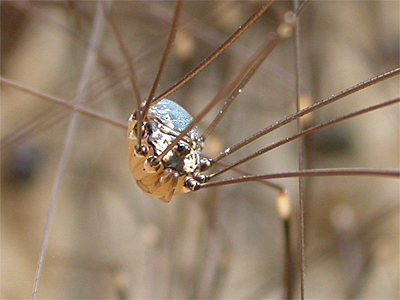 |
The next survey came on July 16th and
on the walls of Worksop Priory, a total of 72 Leiobunum sp.A were
recorded. These were mostly from three aggregations from annually used
locations on the southern and eastern walls. Just four were found on the
shaded, northern wall. A visit on August 12th produced a count of 137,
with a number of Leiobunum sp.A on the northern wall in several small
aggregations and with additional aggregations of 33 and 50 in usual spots on the
southern Priory walls. At the nearby Worksop B&Q on Sandy Lane, a count of 12 Leiobunum sp.A, consisted of mostly sub-adults on the exterior wall of the garden centre area on June 12th, but by the end of July, numbers had greatly increased with a high site count of 127 there on July 31st, but only 106 were recorded on September 13th. In late July, news came of Leiobunum sp.A being found at the junction of Seeley Road/Ilkeston Road in Nottingham on July 5th 2025. I was able to confirm the species via photograph and it seems an aggregation was noted at the time, although no specific count was received. It represents a new site and grid square, so Leiobunum sp.A, is obviously widespread across Nottingham. Just outside the county, Leiobunum sp.A has been found on several properties in Shirebrook. |
|
| .......... | ||
| On August 18th, I had an
appointment in Kirkby-in-Ashfield and with time to spare beforehand, I
took a walk along the Station Street and Diamond Avenue areas, with a
view to checking for harvestmen and Leiobunum sp.A in
particular. I included some small side streets in my search and was both
surprised and delighted to find a total of 25 Leiobunum sp.A,
with one aggregation of 15 on the walls of the local B&M store, with
others in one's and two's nearby. This is another new location for the
species, which must be in every town in the county by now. I also
checked the B&Q store at Sutton-in-Ashfield, where I'd found
Leiobunum sp.A for the first time there in 2024 and found two
present (male and female) on the front of the building. And just a couple of weeks later, after continually searching the walls, houses and shop fronts in Market Warsop, I finally located a sub-adult female on the white walls of the chip shop on Clumber Street. It took many years of looking, before finally turning up just a few hundred yards from my own front door. It represents the 15th, 1km grid square on the species distribution map, but, try as I might, I still can't find it in Retford or Newark despite visiting both towns recently, but it's certainly present somewhere. Back at Worksop Priory and a visit on September 17th proved interesting, although only 28 Leiobunum sp.A were recorded. Aggregations seen on my previous visit a month earlier, probably dispersed because of the strong winds and some heavy showers of recent weeks, but the count was still surprisingly low. But after such a poor count in September, I was pleasantly surprised with a survey on October 22nd producing a total of 14 Leiobunum sp.A. Of this total, were just three females, found well spaced around the Priory walls and 11 males, which I didn't expect, with females generally having the greater longevity in the colder months of the year. 2026 records of Leiobunum sp.A The year started unexpectedly, with the discovery of a large female Leiobunum sp.A on the front of my parent's house at Mapperley in Nottingham on January 1st (per Steve Pendleton). Nice to start 2026 off with a new grid square too and it's the latest ever Nottinghamshire record to date. The present range of Leiobunum sp.A, is shown in the accompanying distribution map on the right. All records are from locations west of the River Trent, but this harvestman surely has to be established in the likes of Newark and Retford? |
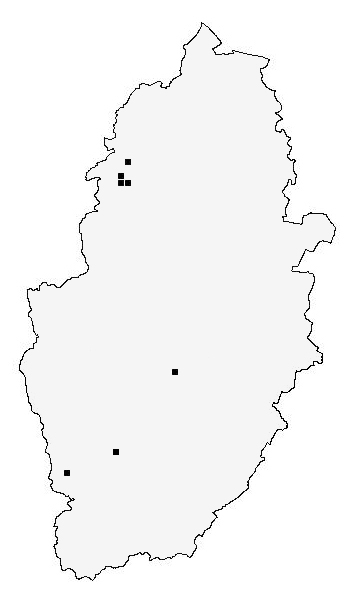 |
| The discovery of Leiobunum sp. A at Worksop in 2009 | ||
| Spiders | ||
| Homepage | ||